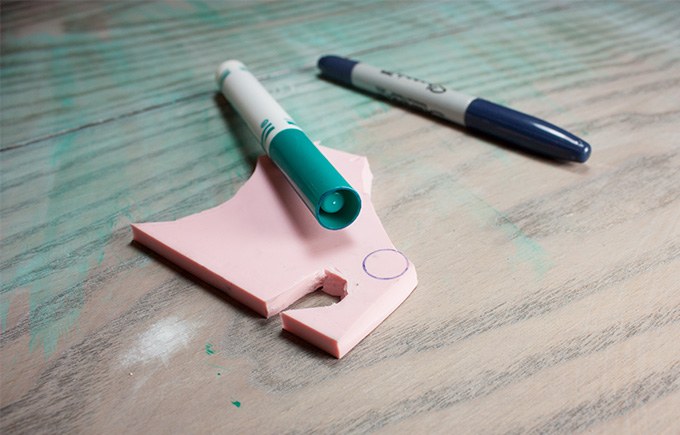
From 2014-2016 I chronicled my crafty endeavors on the site Adventures-in-Making. I’ve selected a few of those DIY’s, Recipes, and other posts to share on the site.
My favorite supplies have changed a lot over the years. Right now I have a loose-leaf system that works great for me, and along with my travel kit, it’s incredibly portable. (Portable tools mean you’ll get more done, more places!)
Since I have a tendency to do things a little differently, I thought I’d share a little about my process and supplies; then let you decide if you think I’m crazy- or a crazy genius.
I’ve included links to many of the supplies, in case you’d like to try them yourself*.
Paper and Stuff

I like to work on 8.5 x 11 inch loose-leaf pages because I can carry them around easily. From time-to-time I’ll cut pages down so I can have an even more portable set- but I keep the same selection of papers.
A. Papers
I use Smooth White Cardstock for early sketches and drawing. Cardstock handles a lot of erasing a redrawing.
When I can’t erase any more, I’ll do additional edits on cheap tracing paper.
I use higher quality Canson Marker Paper for final drawings, and for inking. I tried a bunch of different papers, and this was the best with my Uni-ball pens. It doesn’t bleed too much, and dries quickly enough that I’m less likely to drag my left hand through wet ink.
Graph Paper and Miscellaneous Guide Sheets I’ve found it’s handy to keep guide sheets that I can use with tracing paper. I usually have sheets of graph paper, script slant guides, and other handy shapes I use a lot.
B. Clipboard
I love this low profile aluminum clipboard. It’s lightweight and means I can draw anywhere.
C. Project Filing
I keep each project I’m working on in a clear page protector. When I’m done, I can discard the pieces of my process I no longer need, and retire the whole protector to a binder or other file for safekeeping.
Tool Kit

I do as much work at the store as I do in my studio, so I’ve come up with a very extensive travel kit to carry. (I like to be prepared for everything.)
A. Pencils
I love using Woodless Graphite Pencils for shading, thick lines, and because they are awesome. I use BIC Mechanical Pencils a lot in my early sketching phases. Blackwing Pencils are my newest obsession. The erasers are especially useful, and replaceable! I prefer the harder “Pearl Pencils”.
B. Pencil Sharpener
This small metal pencil sharpener is essential if you want to use anything other than a mechanical pencil.
C. Erasers
I use a Mars Plastic Eraser for heavy duty changes and a narrow eraser for getting into tight spots
D. White Pencil
I often us a white Prismacolor Pencil to correct mistakes that can’t be erased, I also like to be able to draw on surfaces that aren’t white. (See the pictures of my work table.)
E. Ruler
This 6″ Ruler was one of the best things I added to my kit. You can’t eye-ball every line.
F. Compass
For years I used a cheap school compass, and when I upgraded to this guy, suddenly my life got so much better. Perfect for making curves, and circles.
G. Inking Pens
Uni-ball Pens are my preferred pen for inking on marker paper.
H. Scissors
A tiny pair of scissors like this comes in handy often.
I. Permanent Marker
I love the twin tipped Sharpie Markers. Sometimes I want to go nuts and make a permanent drawing impact (ie. leave my tag somewhere.) I don’t usually do that, but a permanent marker is great to have on hand.
J. X-acto Knife
I think everyone should have a quality X-acto Knife. I use this one from Martha Stewart Crafts because the lid stays on well, which is important in a tool that travels around with me. I also like to keep a few extra blades on hand; this box set does just that, and has a place to store the old blades.
K. Glue
It’s important to keep glue around for when you want to add something to your drawings. A glue stick works well, and leaves less mess in your bag. I also carry around a small roll of scotch tape.
L. Miscellaneous Tools
You probably need a Bone folder. I also try to keep something that will poke, but isn’t sharp, like this embossing tool, or a small wooden skewer. Think of other miscellaneous tools you might need – a needle and thread?
M. Pencil Bag
A gorgeous pencil bag will inspire your work. Check out this lovely one from Slide Sideways (now Year End Co.)
—
Well, now you’ve seen what I’ve been working with lately. It’s not your usual collection of art supplies, but life is all about trying unusual things!
*Support Adventures-in-Making by shopping from our Amazon store. We’ve selected a few things that we love, and think you will too. If you purchase through us, you pay no more for those items, but we get a small portion of the sales to further the adventures. Check out the whole store at http://astore.amazon.com/adveinmaki-20





 Although my saddle stapler isn’t very old, they have discontinued the model. You may be able to find this exact model online (it’s a Swingline 615 Saddle Stapler) you can buy the very similar Stanley Bostitch Booklet Stapler
Although my saddle stapler isn’t very old, they have discontinued the model. You may be able to find this exact model online (it’s a Swingline 615 Saddle Stapler) you can buy the very similar Stanley Bostitch Booklet Stapler at Amazon*. Both use standard staples found just about anywhere, so you don’t need to stockpile anything.
is a must-have. If you’re in a pinch, and local, I might even let you use mine.




































You must be logged in to post a comment.